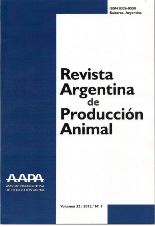View Item
- xmlui.general.dspace_homeCentros Regionales y EEAsCentro Regional CórdobaEEA Marcos JuárezArtículos científicosxmlui.ArtifactBrowser.ItemViewer.trail
- DSpace Home
- Centros Regionales y EEAs
- Centro Regional Córdoba
- EEA Marcos Juárez
- Artículos científicos
- View Item
Influencia de la dieta sobre indicadores de calidad de carne de novillos con diferente composición de Bos taurus y Bos indicus = Influence of diet on quality meat indexes of steers with different composition of Bos taurus and Bos indicus
Abstract
El objetivo de este trabajo fue evaluar la incidencia del componente índico sobre la calidad de carne y su interacción con sistemas de alimentación de alta productividad. Se utilizaron cuatro proporciones de sangre índica: Hereford (0 % índico), Braford 1/4, Braford 3/8 y Braford 1/2 sangre. Cada grupo fue sometido a tres dietas: pastoril exclusiva sobre una consociación de alfalfa y festuca (D1); igual base pastoril que D1 más suplementación con grano de
[ver mas...]
El objetivo de este trabajo fue evaluar la incidencia del componente índico sobre la calidad de carne y su interacción con sistemas de alimentación de alta productividad. Se utilizaron cuatro proporciones de sangre índica: Hereford (0 % índico), Braford 1/4, Braford 3/8 y Braford 1/2 sangre. Cada grupo fue sometido a tres dietas: pastoril exclusiva sobre una consociación de alfalfa y festuca (D1); igual base pastoril que D1 más suplementación con grano de maíz quebrado equivalente al 0,7% del peso vivo animal/día desde ingreso a terminación con interrupción entre noviembre y febrero (D2) y engorde a corral con grano de maíz quebrado, heno de alfalfa, expeller de soja y núcleo vitamínico mineral (D3). Se asignaron 10 animales por tratamiento que ingresaron con un peso promedio de 189,1 (±21,4) kg. Se faenaron conforme alcanzaban estado de terminación comercial determinado visualmente. De cada tratamiento se tomaron 6 novillos al azar de los que se obtuvieron muestras del músculo Longissimus dorsi entre 9º y 11º costilla anatómica a fin de analizar indicadores de calidad. Los pesos de faena fueron estadísticamente diferentes entre genotipos (p<0,05), resultando más pesados los Braford 1/2 (403±55 kg), intermedios Braford 3/8 (399±55 kg) y Braford 1/4 (395±37 kg) y más livianos los Hereford (389±43 kg). El área de ojo de bife siguió la tendencia de los pesos de faena, mientras que la resistencia al esfuerzo de corte fue estadísticamente superior en Braford 3/8 y Braford 1/2 (p<0,05). El contenido de GI, AGS, AGMI, AGPI, relación omega-6/omega-3 y contenido de CLA no presentaron diferencias entre razas (p>0,05). Salvo en AGPI el efecto de las dietas fue significativo (p<0,05). La alimentación a corral generó los menores niveles de CLA y las mayores relaciones omega-6/omega-3 independientemente del tipo racial. Se detectó pérdida de terneza cuando el componente índico superó el 25%.
[Cerrar]
The aim of this study was to evaluate the incidence of indic component on meat quality and its interaction with feeding systems of high productivity. Four proportions of indic genotype were used: Hereford (0 % indic), 1/4 Braford, 3/8 Braford and 1/2 Braford. Each group was subjected to three diets: exclusively pastoral on a mixture of alfalfa and tall fescue (D1); equal pastoral diet that D1 and daily supplementation with cracked corn equivalent to 0.7 %
[ver mas...]
The aim of this study was to evaluate the incidence of indic component on meat quality and its interaction with feeding systems of high productivity. Four proportions of indic genotype were used: Hereford (0 % indic), 1/4 Braford, 3/8 Braford and 1/2 Braford. Each group was subjected to three diets: exclusively pastoral on a mixture of alfalfa and tall fescue (D1); equal pastoral diet that D1 and daily supplementation with cracked corn equivalent to 0.7 % of live weight
animal/day only interrupted between November and February (D2) and feedlot diet with cracked corn, lucerne hay, soybean meal, and mineral vitamin supplement (D3). Ten steers by experimental unit that were admitted to the autumn with 6-7 months of age and an average weight of 189.1 (±21.4) kg were used. The slaughter time was defined at similar degree of
finishing, estimated by visual determination of fatness. Six steers from each treatment were taken at random obtaining samples of Longissimus dorsi muscle at the 9 and 11 rib by physical th th and chemical determination. The slaughter weight was statistically different among genotypes (p<0.05), being the heaviest 1/2 Braford (403±55 kg), middle 3/8 Braford (399±55 kg) and 1/4 Braford (395±37 kg) and the lightest Hereford (389±43 kg). The rib eye area followed the trend of the slaughter weights, while Warner Bratzler shear force was statistically superior in 3/8 Braford and 1/2 Braford (p<0.05). Biochemistry indexes like IMF, SFA, MUFA, PUFA, omega6/omega-3 ratio and CLA levels were not affected by genotypes (p>0.05). On the other way,
except in PUFA, the diet effect was significant (p<0.05). Feedlot diet generated the lowest CLA
levels and the greatest omega-6/omega-3 ratio without significant effects of genotypes (p<0.05).
When the indic component exceeded 25 % a loss of tenderness was detected.
[Cerrar]

Fuente
Revista Argentina de Producción Animal 32 (2) : 175-186 (2012)
Date
2012
Editorial
Asociación Argentina de Producción Animal
ISSN
0326-0550
2314-324X
2314-324X
Formato
pdf
Tipo de documento
artículo
Palabras Claves
Derechos de acceso
Abierto
 Excepto donde se diga explicitamente, este item se publica bajo la siguiente descripción: Creative Commons Attribution-NonCommercial-ShareAlike 2.5 Unported (CC BY-NC-SA 2.5)
Excepto donde se diga explicitamente, este item se publica bajo la siguiente descripción: Creative Commons Attribution-NonCommercial-ShareAlike 2.5 Unported (CC BY-NC-SA 2.5)


